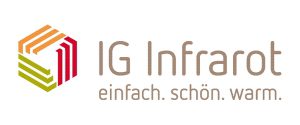
IG Infrarot
Die Initiative.
Das Ziel der IG Infrarot ist es, „Heizen mit Infrarot“ als anerkannte Standardheizlösung für Gebäude zu etablieren. Der benötigte Strom soll dabei vorzugsweise aus erneuerbaren Energien gewonnen werden. Dem wird mit fortschreitender Energiewende immer besser Rechnung getragen.
Sowohl die Energieerzeugung und -verteilung als auch die Wärmeabgabe im Gebäude sollen fester Bestandteil ganzheitlicher Gebäudekonzepte werden, wie sie heute in besonders innovativen Projekten bereits anzutreffen sind.
Leistbare Wärme
Für Private.
Wer Heizungen baut, trägt Verantwortung für die Menschen und für die Umwelt.
Mitglieder der IG Infrarot stehen dafür, verantwortungsvoller zu heizen und umweltbewusster zu handeln. Aus diesem Grund informiert und berät die IG Infrarot über immer effizientere Gebäudekonzepte in Verbindung mit Infrarotheizungen.
Heizen mit Infrarot. einfach. schön. warm.
IG Infrarot Video
Warum ist Heizen mit Infrarot mittels selbst erzeugtem Strom aus erneuerbaren Energien im Verbund mit einem Enerqiespeicher die Zukunft?
Was genau macht eine Infrarotheizung eigentlich? Ganz einfach: Infrarot-Wärmestrahlen erwärmen nicht die Raumluft, sondern sämtliche Oberflächen und Personen im Raum. Die Wärme wird von der Gebäudehülle und den Gegenständen gespeichert und gleichmäßig wieder abgegeben. Aus allen Raumrichtungen kommt somit behagliche Wärme. Eine reine Elektroinstallation, keine Wärmeverluste, mit wenigen Handgriffen montiert. Behagliches Raumklima ohne Staubaufwirbelung, umweltfreundlich, wartungsfrei und absolut sicher.
Und jetzt kommt das Beste: nun kommt Strom aus erneuerbaren Energien und Batteriespeicher ins Spiel. Denn ganz ehrlich: die Zeiten von unverantwortlichem Ressourcenverbrauch für Holz-, Kohle-, Öl- oder Gasheizung mit ausgeholzten Wäldern und rauchenden Schloten sollten ein für allemal der Vergangenheit angehören. Die Zukunft heißt: Strom, der selbst verbraucht wird, kann auch selbst produziert werden. Natürlich kann selbst erzeugter Strom für alle elektrischen Verbraucher verwendet werden. Daraus resultiert weniger Bezug aus dem Stromnetz.
Unser Rezept dafür: Man nehme sauberen Strom aus einer Photovoltaikanlage, steigere den Eigenverbrauch durch einen Batteriespeicher, dazu nach Bedarf günstigen Infrarot-Ökostrom aus dem Netz. Fehlt nur noch ein optimal gedämmtes Haus und schon ist wohlige Wärme mit höchstem Wohlfühlfaktor garantiert.
Die Vision der Interessengemeinschaft Infrarot: Heizen mit Infrarot ist Standard in Gebäuden. Dabei wird Strom vorzugsweise aus erneuerbaren Energien genutzt.
Heizen mit Infrarot eben einfach. schön. warm.
